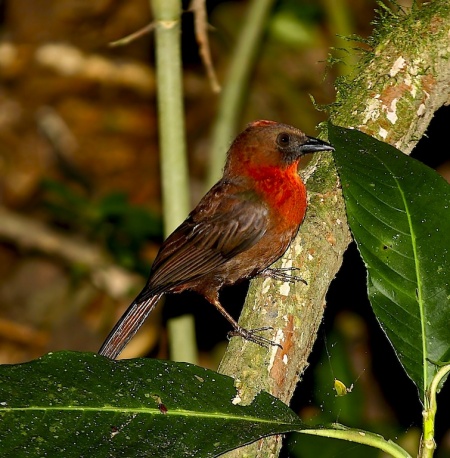m (→Identification) |
(Imp sizes. Picture of subspeies. Picture captions. Taxonomy expanded. Some extra info. References updated.) |
||
| (One intermediate revision by one other user not shown) | |||
| Line 1: | Line 1: | ||
| + | [[Image:Red-throated_Ant-tanager_(male)StanleyJones.jpg|thumb|450px|right|Subspecies ''fuscicauda''<br />Photo © by {{user|Stanley+Jones|Stanley Jones}}<br>Location: Selva Verde Lodge, Sarapiqui, Heredia Province, [[Costa Rica]], March 2006]] | ||
;[[: Category:Habia|Habia]] fuscicauda | ;[[: Category:Habia|Habia]] fuscicauda | ||
| − | + | ||
==Identification== | ==Identification== | ||
| − | + | 18–20 cm (7-8 in) | |
| + | *Dark red head | ||
| + | *Scarlet crown patch (generally concealed) | ||
| + | *Dusky upperparts | ||
| + | *Bright red throat | ||
| + | *Paler underparts | ||
| + | *Strong dark bill<br /> | ||
| + | Female: brownish-olive overall plumage, paler and greyer underparts, yellow throat and small pale yellow crown stripe. <br />Young birds are brown, lacking the throat and crown patches. | ||
===Similar Species=== | ===Similar Species=== | ||
| − | Very difficult to distinguish from the [[Red-crowned Ant Tanager]]. However, this species has darker | + | [[Image:red-throated_ant-tanger_F.jpg|thumb|350px|right|Female<br />Photo © by {{user|Cedric+K.|Cedric K.}} <br />Parque Natural Metropolitano, [[Panama]], April 2009]] |
| + | Very difficult to distinguish from the [[Red-crowned Ant Tanager]]. However, this species has darker [[Topography#Heads|lores]], and the red or yellow crown stripe lacks the black edge found on the Red-crowned Ant Tanager. Both these differences are subtle; best differentiation is voice. | ||
==Distribution== | ==Distribution== | ||
| − | [[Mexico]] to [[Panama]] and [[Colombia]] | + | [[Central America|Central]] and [[South America]]: found from [[Mexico]] to [[Panama]] and [[Colombia]] |
| − | |||
==Taxonomy== | ==Taxonomy== | ||
| + | ====Subspecies==== | ||
| + | [[Image:Red-throated Ant-Tanager4.jpg|thumb|350px|right|Subspecies ''insularis''<br />Photo © by {{user|firecrest15|firecrest15}}<br />Reserve Toh, Quintana Roo, [[Mexico]], 29 April 2019]] | ||
Six subspecies are recognized:<sup>[[#References|[1]]]</sup> | Six subspecies are recognized:<sup>[[#References|[1]]]</sup> | ||
| − | * H. f. salvini | + | *''H. f. salvini'': |
| − | * H. f. insularis | + | :*South East [[Mexico]] (San Luis Potosí and Veracruz) to [[El Salvador ]] |
| − | * H. f. discolor | + | *''H. f. insularis'': |
| − | * H. f. fuscicauda | + | :*Yucatán Peninsula, Meco I., Isla Mujeres and northern [[Guatemala]] |
| − | * H. f. willisi | + | *''H. f. discolor'': |
| − | * H. f. erythrolaema | + | :*Tropical [[Nicaragua]] |
| + | *''H. f. fuscicauda'': | ||
| + | :*Extreme southern Nicaragua to extreme western [[Panama]] | ||
| + | *''H. f. willisi'': | ||
| + | :*Central Panama (north-eastern Coclé and Colón to western San Blas) | ||
| + | *''H. f. erythrolaema'': | ||
| + | :*[[Caribbean]] coast of northern [[Colombia]] | ||
==Habitat== | ==Habitat== | ||
| − | + | Older second growth, forest borders and surrounding shrubby areas. | |
==Behaviour== | ==Behaviour== | ||
| − | + | ====Breeding==== | |
| − | + | They construct a cup shaped nest in the fork of a shrub or tree. Their clutch consists of 2-3 white eggs. It is thought that at times they are co-operative breeders. | |
| + | ====Diet==== | ||
| + | Their main diet consists of insects, arthropods such as ants and caterpillars. They will also eat some fruit. | ||
==References== | ==References== | ||
| − | #{{Ref- | + | #{{Ref-Clements6thAug18}}#Handbook of the Birds of the World Alive (retrieved June 2019) |
{{Ref}} | {{Ref}} | ||
==External Links== | ==External Links== | ||
{{GSearch|Habia+fuscicauda}} | {{GSearch|Habia+fuscicauda}} | ||
[[Category:Birds]][[category:Habia]] | [[Category:Birds]][[category:Habia]] | ||
Latest revision as of 21:03, 20 June 2019

Photo © by Stanley Jones
Location: Selva Verde Lodge, Sarapiqui, Heredia Province, Costa Rica, March 2006
- Habia fuscicauda
Identification
18–20 cm (7-8 in)
- Dark red head
- Scarlet crown patch (generally concealed)
- Dusky upperparts
- Bright red throat
- Paler underparts
- Strong dark bill
Female: brownish-olive overall plumage, paler and greyer underparts, yellow throat and small pale yellow crown stripe.
Young birds are brown, lacking the throat and crown patches.
Similar Species
Very difficult to distinguish from the Red-crowned Ant Tanager. However, this species has darker lores, and the red or yellow crown stripe lacks the black edge found on the Red-crowned Ant Tanager. Both these differences are subtle; best differentiation is voice.
Distribution
Central and South America: found from Mexico to Panama and Colombia
Taxonomy
Subspecies
Six subspecies are recognized:[1]
- H. f. salvini:
- South East Mexico (San Luis Potosí and Veracruz) to El Salvador
- H. f. insularis:
- Yucatán Peninsula, Meco I., Isla Mujeres and northern Guatemala
- H. f. discolor:
- Tropical Nicaragua
- H. f. fuscicauda:
- Extreme southern Nicaragua to extreme western Panama
- H. f. willisi:
- Central Panama (north-eastern Coclé and Colón to western San Blas)
- H. f. erythrolaema:
Habitat
Older second growth, forest borders and surrounding shrubby areas.
Behaviour
Breeding
They construct a cup shaped nest in the fork of a shrub or tree. Their clutch consists of 2-3 white eggs. It is thought that at times they are co-operative breeders.
Diet
Their main diet consists of insects, arthropods such as ants and caterpillars. They will also eat some fruit.
References
- Clements, J. F., T. S. Schulenberg, M. J. Iliff, D. Roberson, T. A. Fredericks, B. L. Sullivan, and C. L. Wood. 2018. The eBird/Clements checklist of birds of the world: v2018. Downloaded from http://www.birds.cornell.edu/clementschecklist/download/
- Handbook of the Birds of the World Alive (retrieved June 2019)
Recommended Citation
- BirdForum Opus contributors. (2025) Red-throated Ant Tanager. In: BirdForum, the forum for wild birds and birding. Retrieved 12 May 2025 from https://www.birdforum.net/opus/Red-throated_Ant_Tanager





